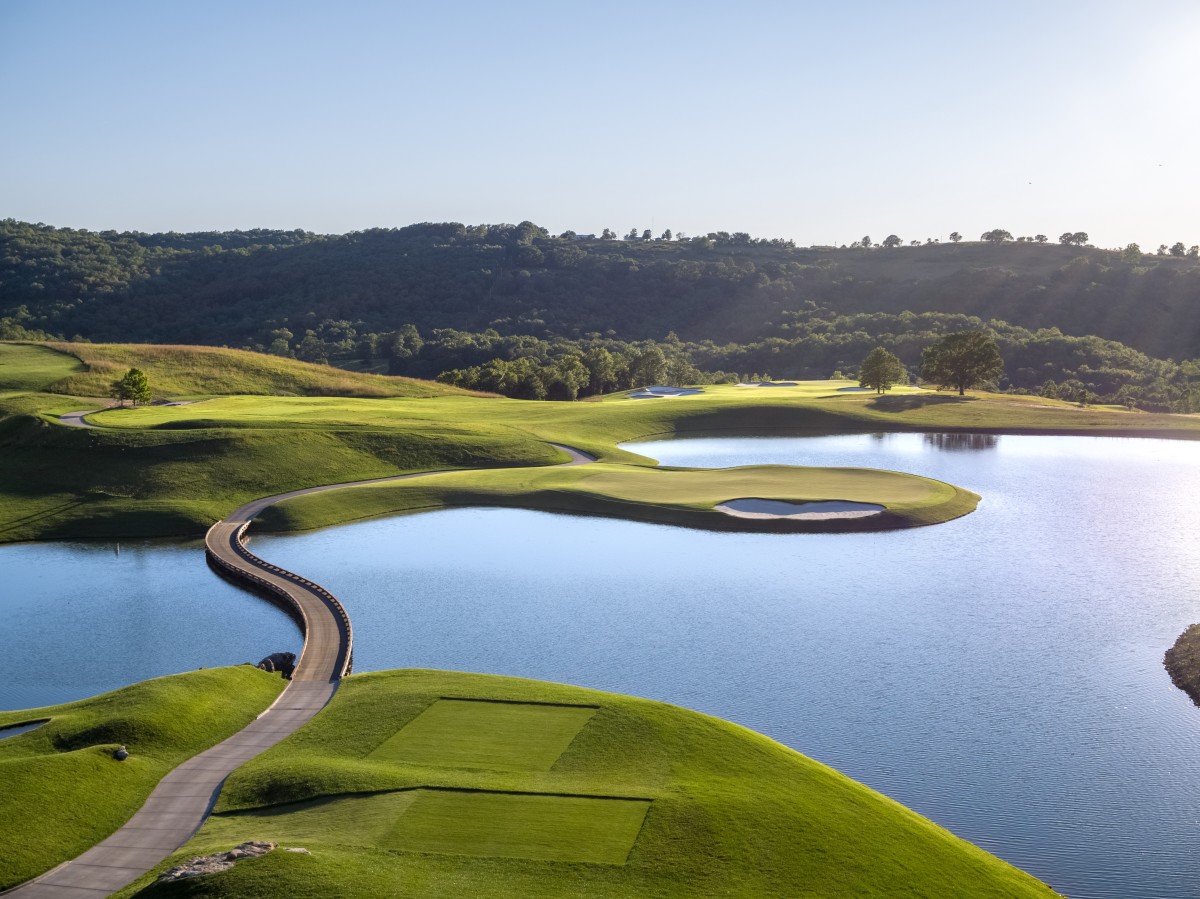Seven Courses That Are Worthy of Hosting a Future U.S. Open

Following last week’s announcement that five additional U.S. Opens are headed to Pennsylvania's Oakmont Country Club and Merion Golf Club between 2030 and 2050, it’s a clear case of the rich getting richer. Both venues are drenched in history and feature exceptional architecture. Yet, both are also very old and very private.
Is there a place anymore in the U.S. Open rota for a modern and perhaps purely public course? The U.S. Open dance card is full through 2027, and the tournament also has a home for 2029 and 2030. Somehow, a gap exists in 2028. A plethora of worthy candidates awaits to fill that hole, including two controversial public layouts that deserve a second U.S. Open opportunity -- Chambers Bay and Erin Hills.
If the only criteria were “fun, testing and architecturally intriguing,” here are seven modern courses that deserve a shot to host the 2028 U.S. Open.
Sand Hills, Mullen, Neb.
A fantasy pick because it’s impossibly remote, Sand Hills is situated more than 200 miles from the red-clad Cornhusker crazies in Lincoln, which has the nearest commercial airport. Still, this private, 1995 Bill Coore-Ben Crenshaw design, considered the best course built in the past 60 years, is worth the journey. Hewn from wind-blasted, sandhill-laced, rippled prairie land and blanketed with tall, golden grasses, it’s sufficiently testing at 7,089 yards, especially with its exquisitely crafted, Dornoch-style greens that are propped up just enough to demand superior approach shots and chipping.
Bandon Dunes Golf Resort (Bandon Dunes), Bandon, Ore.
On July 20, 2021, the USGA announced that it take 13 USGA amateur championships to Bandon Dunes over a 23-year period. Eight different championships will be held at the resort including the Walker Cup and Curtis Cup. In 2032 and 2041, the U.S. Amateur and U.S. Women’s Amateur will be contested concurrently. Undoubtedly, these events will be spread out over Bandon’s five championship courses, each of which is ranked among the top 15 public-access tracks in the U.S.
What’s missing? A U.S. Open.
Even casual observers of the 2020 U.S. Amateur were wowed by the host course, Bandon Dunes. The original layout at the resort, Bandon Dunes is a David McLay Kidd design that dazzled as a match-play spread, replete with towering sand dunes, ocean vistas and risk-reward choices. Amid breeze-fueled, firm-and-fast conditions, with an emphasis on proper ball flight and the ground game, Bandon boasted a cumulative stroke-play average in 36-hole qualifying of 74.262. Moreover, it can be easily stretched another 300 yards from the 6,958 yards it played that week. The drama inherent in playing the drivable par-4 16th next to the Pacific would make for a fabulous conclusion to a U.S. Open.
Mauna Kea, Kohala Coast, Hawaii
In December 1964, Jack Nicklaus opened Mauna Kea by beating pals Arnold Palmer and Gary Player in the televised “Big 3” match. Afterward, he called the Robert Trent Jones Sr. design, “the most fun golf course I’ve ever played.” It’s also U.S. Open-worthy. Just consider the design pedigree. The original “Open Doctor,” RTJ Sr., considers Mauna Kea one of his five favorite designs of his more than 400 courses. His oldest son, Robert Trent Jones Jr., architect of 2015 U.S. Open venue Chambers Bay, tweaked Mauna Kea in the 1970s. The course was further refined 15 years ago by the most recent “Open Doctor,” Trent’s younger son, Rees.
The weather will be spectacular, given its location on the dry Kohala Coast of the Big Island. The scenery? Even more spectacular. It occupies a rolling, lava-flecked landscape overlooking and occasionally interacting with the Pacific Ocean. The visuals are overwhelming at the gargantuan 272-yard, par-3 3rd hole that asks for a smash across pounding Pacific surf to a huge green ringed with a necklace of bunkers. Overall, Mauna Kea would offer a prodigious challenge to the game’s best. With wind a constant factor, its 7,370 yards, deep bunkers, elevated greens and lava rough pose a stern test.
French Lick Resort (Pete Dye), French Lick, Ind.
Having local hero Larry Bird’s long-range touch would be helpful to cope with this gorgeous, 12-year-old, 8,102-yard Pete Dye brute that plays atop ridges and through valleys amid the rolling countryside of southern Indiana. Rough-covered hills, a fistful of “volcano” bunkers and holes such as the 301-yard, par-3 (yes, par-3) 16th will provide supreme challenge. Colin Montgomerie captured the 2015 Senior PGA Championship here and Dye’s handiwork fully tested competitors at the Big Ten Championships from 2012-2014, with 5-under-par 283 the lowest score recorded.
French Lick has two huge hotels, plus casino gaming and is a 60-minute ride from more hotels and the Louisville Airport. Dye deserves a U.S. Open.
Gozzer Ranch Golf and Lake Club, Harrison, Idaho
Located 100 miles south of the Canadian border, Coeur d’Alene has long been a favored getaway thanks to its incomparable, 25-mile-long namesake lake, once called one of the five most beautiful lakes in the world by "National Geographic." Summer vacationers warm to delightful daytime high temperatures that range from 76 to 86 degrees and golfers cherish the added daylight from Coeur d’Alene being situated so far north. Add one of Tom Fazio’s finest creations next to the lake and you have my idea of an ideal U.S. Open site.
Gozzer Ranch is private, but the club vibe is like a summer camp for families. Fazio’s 7,317-yard, 14-year-old creation dazzles with rocky bluffs that sprout 100-foot spires, mature pines and stunning lake views. Tattered-edge bunkers, framed by wispy fescues, several horizon greens and inspired risk-reward options add further beauty and challenge. True, the nearest major airport is Spokane, a 90-minute drive away, but for a U.S. Open on the lake, it's worth the effort.
Streamsong Resort (Black), Bowling Green, Fla.
Hanse Golf Course Design’s Gil Hanse and Jim Wagner are the new “Open Doctors.” Their restoration craftsmanship will be on display at the 2022, 2023 and 2025 U.S. Opens. It would be a nice tip of the cap to see a U.S. Open visit one of their original designs. How about 2028?
Yes, Streamsong is in Florida, central Florida at that, so heat, humidity, bugs, soft conditions and potential thunderstorms all have to be factored in. But you could say that about nearly every U.S. Open venue in the Northeast or Midwest. Streamsong Black resembles none of those other northern sites. Hewn from reclaimed phosphate mining land, the golf canvas features a sandy base, gigantic, dune-like spoil piles and unusually rolling (for Florida) terrain. Even in mid-June, the ball will roll. The Black is brawnier than its elder siblings, Red and Blue, with wider fairways, bigger bunkers, larger greens and more expansive long views. The Black is also the longest at 7,320 yards, par 73. Cut a few of the par-5s back to 4s and you’ll have a classic Open setup. Get the boldly contoured greens firm and fast enough and the Black will present a compelling test.

Big Cedar Lodge (Payne’s Valley), Ridgedale, Mo.
Tiger Woods Design’s first public course honors two-time U.S. Open winner Payne Stewart. The USGA should return the honor, with the 2028 U.S. Open. Tiger opened Payne’s Valley in September 2020 with a televised exhibition involving two other U.S. Open winners, Rory McIlroy and Justin Rose, joined by Justin Thomas, who likely will win a national championship of his own one day. What they experienced was a course of remarkable natural beauty, studded with the drama of the Ozarks -- tree-cloaked ridges and valleys, tumbling terrain and exposed rock at every turn.
Most talked about was the extra hole, the 19th, an island-green par 3 of 136 yards framed by waterfalls splashing down the sides of massive rock walls. For the 18-hole, 7,370-yard U.S. Open layout, the 188-yard 5th and the 183-yard 10th are close runners-up in visual splendor, the former played to a peninsula green, the latter a downhill plunge over water. Given the lodging and activities components on-site, with Bass Pro Shops domo Johnny Morris as host, plus more pleasing attractions in nearby Branson, a U.S. Open excursion into Payne’s Valley would be just fine.
